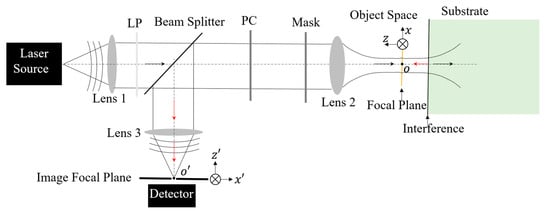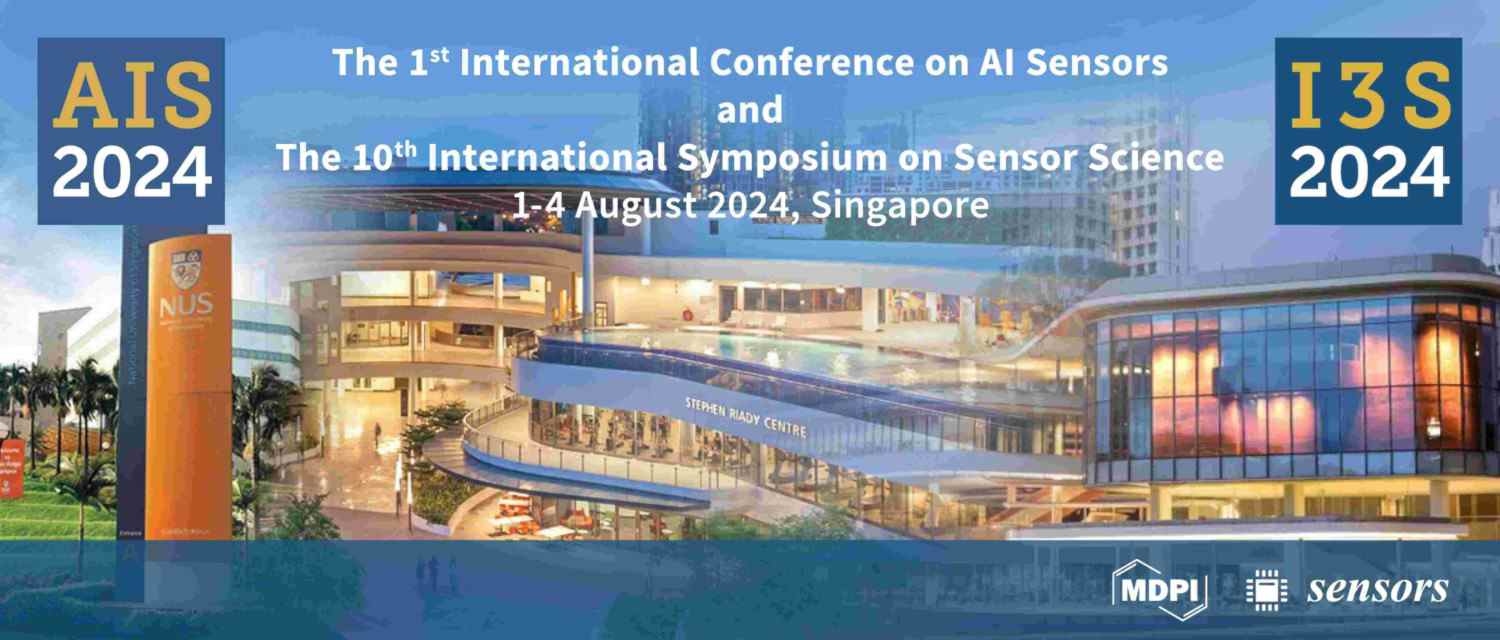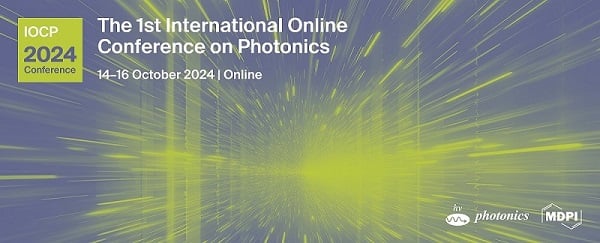-
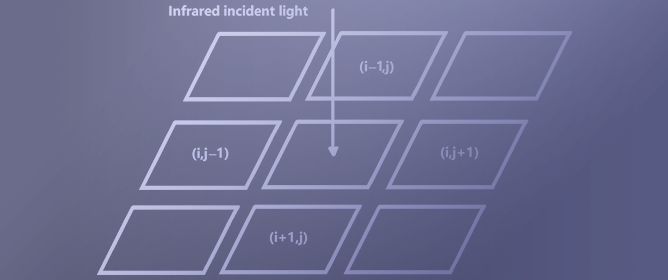 A Novel Eye Hole Method for the Crosstalk Test of Small Element Infrared Focal Plane Arrays
A Novel Eye Hole Method for the Crosstalk Test of Small Element Infrared Focal Plane Arrays -
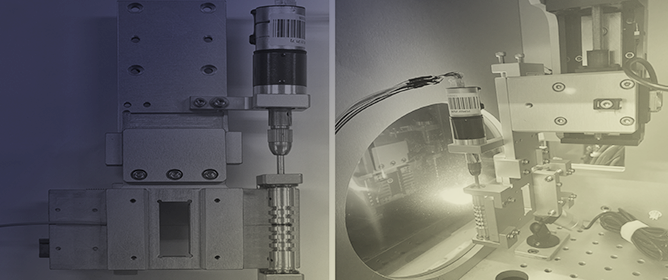 Application of Micro-Tubing Reeling System to Serial Femtosecond Crystallography
Application of Micro-Tubing Reeling System to Serial Femtosecond Crystallography -
 On-Chip Multichannel Dispersion Compensation and Wavelength Division MUX/DeMUX Using Chirped-Multimode-Grating-Assisted Counter-Directional Coupler
On-Chip Multichannel Dispersion Compensation and Wavelength Division MUX/DeMUX Using Chirped-Multimode-Grating-Assisted Counter-Directional Coupler -
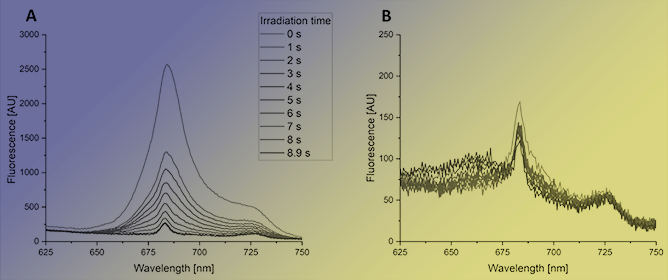 Antibiotic Effect of High-Power Blue Laser Radiation
Antibiotic Effect of High-Power Blue Laser Radiation -
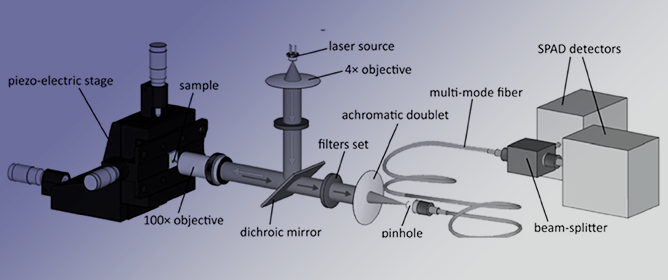 Solid-State Color Centers for Single-Photon Generation
Solid-State Color Centers for Single-Photon Generation
Journal Description
Photonics
Photonics
is an international, scientific, peer-reviewed, open access journal on the science and technology of optics and photonics, published monthly online by MDPI.
- Open Access— free for readers, with article processing charges (APC) paid by authors or their institutions.
- High Visibility: indexed within Scopus, SCIE (Web of Science), Inspec, CAPlus / SciFinder, and other databases.
- Rapid Publication: manuscripts are peer-reviewed and a first decision is provided to authors approximately 15.5 days after submission; acceptance to publication is undertaken in 2.7 days (median values for papers published in this journal in the second half of 2023).
- Recognition of Reviewers: reviewers who provide timely, thorough peer-review reports receive vouchers entitling them to a discount on the APC of their next publication in any MDPI journal, in appreciation of the work done.
- Companion journal: Optics.
Impact Factor:
2.4 (2022);
5-Year Impact Factor:
2.4 (2022)
Latest Articles
Far-Field Super-Resolution Optical Microscopy for Nanostructures in a Reflective Substrate
Photonics 2024, 11(5), 409; https://doi.org/10.3390/photonics11050409 (registering DOI) - 27 Apr 2024
Abstract
The resolution of an optical microscope is determined by the overall point spread function of the system. When examining structures significantly smaller than the wavelength of light, the contribution of the background or surrounding environment can profoundly affect the point spread function. This
[...] Read more.
The resolution of an optical microscope is determined by the overall point spread function of the system. When examining structures significantly smaller than the wavelength of light, the contribution of the background or surrounding environment can profoundly affect the point spread function. This research delves into the impact of reflective planar substrate structures on the system’s resolution. We establish a comprehensive forward imaging model for a reflection-type confocal laser scanning optical microscope, incorporating vector field manipulation to image densely packed nanoparticle clusters. Both theoretical and experimental findings indicate that the substrate causes an interference effect between the background field and the scattered field from the nanoparticles, markedly enhancing the overall spatial resolution. The integration of vector field manipulation with an interferometric scattering approach results in superior spatial resolution for imaging isolated particles and densely distributed nanoscale particle clusters even with deep subwavelength gaps as small as 20 nm between them. However, the method still struggles to resolve nanoparticles positioned directly next to each other without any gap, necessitating further work to enhance the resolving ability. This may involve techniques like deconvolution or machine learning-based post-processing methods.
Full article
(This article belongs to the Special Issue Design and Applications of Optical Microscopes)
►
Show Figures
Open AccessArticle
Rapid Fabrication of Yttrium Aluminum Garnet Microhole Array Based on Femtosecond Bessel Beam
by
Heng Yang, Yuan Yu, Tong Zhang, Shufang Ma, Lin Chen, Bingshe Xu and Zhiyong Wang
Photonics 2024, 11(5), 408; https://doi.org/10.3390/photonics11050408 (registering DOI) - 27 Apr 2024
Abstract
High-aspect-ratio microholes, the fundamental building blocks for microfluidics, optical waveguides, and other devices, find wide applications in aerospace, biomedical, and photonics fields. Yttrium aluminum garnet (YAG) crystals are commonly used in optical devices due to their low stress, hardness, and excellent chemical stability.
[...] Read more.
High-aspect-ratio microholes, the fundamental building blocks for microfluidics, optical waveguides, and other devices, find wide applications in aerospace, biomedical, and photonics fields. Yttrium aluminum garnet (YAG) crystals are commonly used in optical devices due to their low stress, hardness, and excellent chemical stability. Therefore, finding efficient fabrication methods to produce high-quality microholes within YAG crystals is crucial. The Bessel beam, characterized by a uniform energy distribution along its axis and an ultra-long depth of focus, is highly suitable for creating high-aspect-ratio structures. In this study, an axicon lens was used to shape the spatial profile of a femtosecond laser into a Bessel beam. Experimental verification showed a significant improvement in the high aspect ratio of the microholes produced in YAG crystals using the femtosecond Bessel beam. This study investigated the effects of the power and defocus parameters of single-pulse Bessel beams on microhole morphology and size, and microhole units with a maximum aspect ratio of more than 384:1 were obtained. Based on these findings, single-pulse femtosecond Bessel processing parameters were optimized, and an array of 181 × 181 microholes in a 400 μm thick YAG crystal was created in approximately 13.5 min. The microhole array had a periodicity of 5 μm and a unit aspect ratio of 315:1, with near-circular top and subface apertures and high repeatability.
Full article
(This article belongs to the Special Issue Laser Processing and Modification of Materials)
►▼
Show Figures
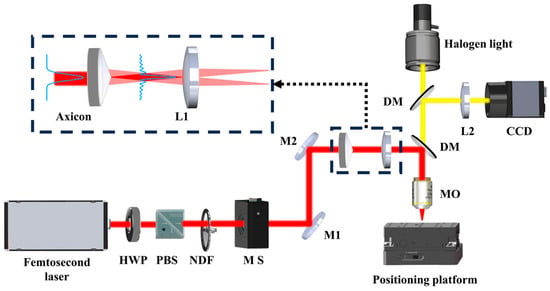
Figure 1
Open AccessArticle
Evaluation of an Erbium-Doped Fiber Ring Laser as an Edge Filtering Device for Fiber Bragg Grating Sensor Interrogation
by
Nikolaos A. Stathopoulos, Christos Lazakis, Iraklis Simos and Christos Simos
Photonics 2024, 11(5), 407; https://doi.org/10.3390/photonics11050407 (registering DOI) - 27 Apr 2024
Abstract
An easy-to-implement and cost-effective Fiber Bragg Grating (FBG) sensor interrogation technique based on a ring Erbium-Doped Fiber Laser (EDFL) topology is proposed and experimentally assessed. The FBG sensor is part of the EDFL cavity and must have a central wavelength located within the
[...] Read more.
An easy-to-implement and cost-effective Fiber Bragg Grating (FBG) sensor interrogation technique based on a ring Erbium-Doped Fiber Laser (EDFL) topology is proposed and experimentally assessed. The FBG sensor is part of the EDFL cavity and must have a central wavelength located within the linear region of the EDF’s amplified spontaneous emission (ASE) spectrum, which occurs at between 1530 and 1540 nm. In this manner, the wavelength-encoded response of the FBG under strain is converted to a linear variation in the laser output power, removing the need for spectrum analysis as well as any limitations from the use of external edge-filtering components. In addition, the laser linewidth is significantly reduced with respect to the FBG bandwidth, thus improving the resolution of the system, whereas its sensitivity can be controlled through pumping power. The performance of the system has been characterized by modeling and experiments for EDFs with different lengths, doping concentrations, and pumping power levels. The influence of mode-hopping in the laser cavity on the resolution and accuracy of the system has also been investigated.
Full article
(This article belongs to the Special Issue Fiber Optic Sensors: Science and Applications)
Open AccessArticle
Experimental Study of Fast Orthogonal Frequency Division Multiplexing Transmission over a Random Media Channel for Optical Wireless Communications
by
Lu Zhang and Yanan Chen
Photonics 2024, 11(5), 406; https://doi.org/10.3390/photonics11050406 - 26 Apr 2024
Abstract
In this paper, a 4 amplitude shift keying (4-ASK) fast orthogonal frequency division multiplexing (FOFDM) scheme was experimentally investigated over a turbulent air–water channel for optical wireless communications. The experiment results showed that the 4-ASK-FOFDM modulated signals were not sensitive to weak atmospheric
[...] Read more.
In this paper, a 4 amplitude shift keying (4-ASK) fast orthogonal frequency division multiplexing (FOFDM) scheme was experimentally investigated over a turbulent air–water channel for optical wireless communications. The experiment results showed that the 4-ASK-FOFDM modulated signals were not sensitive to weak atmospheric turbulence, and the bit-error rate (BER) was lower than the 7% forward error correction (FEC) limit of 3.8 × 10−3. Under the condition of the same spectra efficiency, the 4-ASK-FOFDM scheme just had a tiny performance penalty compared to the 16-QAM-OFDM scheme. Consequently, the 4-ASK-FOFDM scheme is a promising alternative to the conventional 16-QAM-OFDM scheme in optical wireless communications.
Full article
(This article belongs to the Special Issue Underwater Optical Communications Channel Models: Trends and Challenges)
Open AccessArticle
High Fidelity Full-Color Optical Sectioning Structured Illumination Microscopy by Fourier Domain Based Reconstruction
by
Shipei Dang, Jia Qian, Wang Ma, Rui Ma, Xing Li, Siying Wang, Chen Bai, Dan Dan and Baoli Yao
Photonics 2024, 11(5), 405; https://doi.org/10.3390/photonics11050405 - 26 Apr 2024
Abstract
The natural color of biological specimens plays a crucial role in body protection, signaling, physiological adaptations, etc. Full-color optical sectioning structured illumination microscopy (OS-SIM) color is a promising approach that can reconstruct biological specimens in three-dimension meanwhile maintaining their natural color. Full-color OS-SIM
[...] Read more.
The natural color of biological specimens plays a crucial role in body protection, signaling, physiological adaptations, etc. Full-color optical sectioning structured illumination microscopy (OS-SIM) color is a promising approach that can reconstruct biological specimens in three-dimension meanwhile maintaining their natural color. Full-color OS-SIM takes the advantages of rapid imaging speed, compatibility with fluorescence and non-fluorescence samples, compact configuration, and low cost. However, the commonly used HSV-RMS reconstruction algorithm for full-color OS-SIM faces two issues to be improved. One is the RMS (root-mean-square) OS reconstruction algorithm is prone to background noise, and the other is the reconstruction is bound in RGB and HSV color spaces, consuming more reconstructing time. In this paper, we propose a full-color Fourier-OS-SIM method that allows for the OS reconstruction using the high-frequency spectrum of the sample and thus is immune to the low-frequency background noise. The full-color Fourier-OS-SIM directly runs in the RGB color space, providing an easy way to restore the color information. Simulation and experiments with various samples (pollen grains and tiny animals) demonstrate that the full-color Fourier-OS-SIM method is superior to the HSV-RMS method regarding background noise suppression. Moreover, benefiting from the background noise suppression merit, the quantitative morphological height map analysis with the full-color Fourier-OS-SIM method is more accurate. The proposed full-color Fourier-OS-SIM method is expected to find broad applications in biological and industrial fields where the 3D morphology and the color information of objects both need to be recovered.
Full article
(This article belongs to the Special Issue Emerging Topics in Structured Light)
►▼
Show Figures
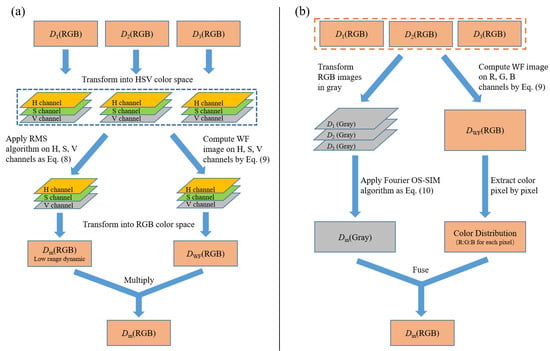
Figure 1
Open AccessArticle
Adaptive Modulation Scheme for Soft-Switching Hybrid FSO/RF Links Based on Machine Learning
by
Junhu Shao, Yishuo Liu, Xuxiao Du and Tianjiao Xie
Photonics 2024, 11(5), 404; https://doi.org/10.3390/photonics11050404 - 26 Apr 2024
Abstract
A hybrid free-space optical (FSO) and radio frequency (RF) communication system has been considered an effective way to obtain a good trade-off between spectrum utilization efficiency and high-rate transmission. Utilizing artificial intelligence (AI) to deal with the switching and rate adaption problems between
[...] Read more.
A hybrid free-space optical (FSO) and radio frequency (RF) communication system has been considered an effective way to obtain a good trade-off between spectrum utilization efficiency and high-rate transmission. Utilizing artificial intelligence (AI) to deal with the switching and rate adaption problems between FSO/RF links, this paper investigated their modulation adapting mechanism based on a machine learning (ML) algorithm. Hybrid link budgets were estimated for different modulation types in various environments, particularly severe weather conditions. For the adaptive modulation (AM) scheme with different order PPM/PSK/QAM, a rate-compatible soft-switching model for hybrid FSO/RF links was established with a random forest algorithm based on ML. With a given target bit error rate, the model categorized a link budget threshold of the hybrid FSO/RF system over a training data set from local weather records. The switching and modulation adaption accuracy were tested over the testing weather data set especially focusing on rain and fog. Simulation results show that the proposed adaptive modulation scheme based on the random forest algorithm can have a good performance for soft-switching hybrid FSO/RF communication links.
Full article
(This article belongs to the Special Issue Next-Generation Free-Space Optical Communication Technologies)
►▼
Show Figures
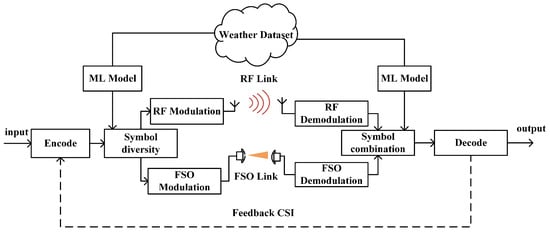
Figure 1
Open AccessArticle
VLCMnet-Based Modulation Format Recognition for Indoor Visible Light Communication Systems
by
Xin Zheng, Ying He, Chong Zhang and Pu Miao
Photonics 2024, 11(5), 403; https://doi.org/10.3390/photonics11050403 - 26 Apr 2024
Abstract
In indoor visible light communication (VLC), the received signals are subject to severe interference due to factors such as high-brightness backgrounds, long-distance transmissions, and indoor obstructions. This results in an increase in misclassification for modulation format recognition. We propose a novel model called
[...] Read more.
In indoor visible light communication (VLC), the received signals are subject to severe interference due to factors such as high-brightness backgrounds, long-distance transmissions, and indoor obstructions. This results in an increase in misclassification for modulation format recognition. We propose a novel model called VLCMnet. Within this model, a temporal convolutional network and a long short-term memory (TCN-LSTM) module are utilized for direct channel equalization, effectively enhancing the quality of the constellation diagrams for modulated signals. A multi-mixed attention network (MMAnet) module integrates single- and mixed-attention mechanisms within a convolutional neural network (CNN) framework specifically for constellation image classification. This allows the model to capture fine-grained spatial structure features and channel features within constellation diagrams, particularly those associated with high-order modulation signals. Experimental results obtained demonstrate that, compared to a CNN model without attention mechanisms, the proposed model increases the recognition accuracy by 19.2%. Under severe channel distortion conditions, our proposed model exhibits robustness and maintains a high level of accuracy.
Full article
(This article belongs to the Topic Machine Learning in Communication Systems and Networks, 2nd Edition)
►▼
Show Figures
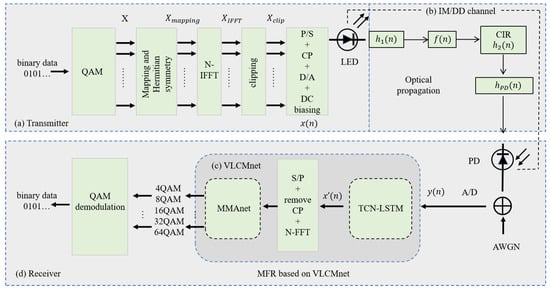
Figure 1
Open AccessArticle
The Application of Optical Sensors with Built-in Anchor-like Cavities in the Detection of Hemoglobin Concentration
by
Wen Jiang, Shubin Yan, Yiru Su, Chong Wang, Taiquan Wu, Yang Cui, Chuanhui Zhu, Yi Zhang, Xiangyang Mu and Guowang Gao
Photonics 2024, 11(5), 402; https://doi.org/10.3390/photonics11050402 - 26 Apr 2024
Abstract
This paper introduces a refractive index sensor based on Fano resonance, utilizing a metal–insulator–metal (MIM) waveguide structure with an Anchor-like cavity. This study utilizes the finite element method (FEM) for analyzing the propagation characteristics of the structure. The evaluation concentrated on assessing how
[...] Read more.
This paper introduces a refractive index sensor based on Fano resonance, utilizing a metal–insulator–metal (MIM) waveguide structure with an Anchor-like cavity. This study utilizes the finite element method (FEM) for analyzing the propagation characteristics of the structure. The evaluation concentrated on assessing how the refractive index and the structure’s geometric parameters affect its sensing characteristics. The designed structure demonstrates optimum performance, achieving a maximum sensitivity of 2440 nm/RIU and an FOM of 63. Given its high sensitivity, this nanoscale refractive index sensor is ideal for detecting hemoglobin concentrations in blood, and the sensor’s sensitivity is 0.6 nm·g/L, aiding in clinical prevention and treatment.
Full article
(This article belongs to the Special Issue New Perspectives in Optical Design)
►▼
Show Figures
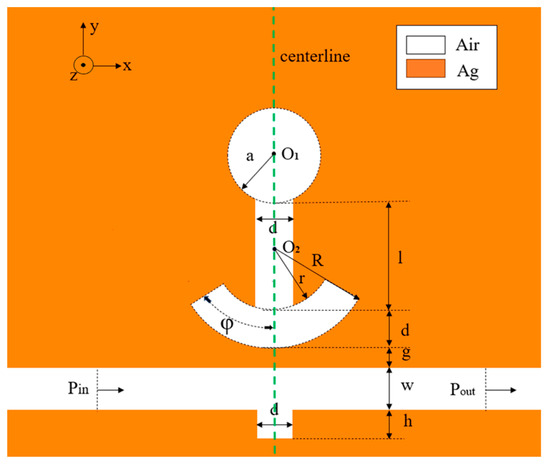
Figure 1
Open AccessCommunication
Line-of-sight Initial Pointing Model of Space Dynamic Optical Network and Its Verification
by
Shu Chen, Xin Zhao, Xiaoying Ding, Xiaoyun Wu and Dewang Liu
Photonics 2024, 11(5), 401; https://doi.org/10.3390/photonics11050401 - 26 Apr 2024
Abstract
In dynamic space networks, achieving high precision and fast initial pointing of the optical line of sight (LOS) is the key goal in developing this technology. It is the premise and basis of realizing optical LOS capture. Based on the composition and working
[...] Read more.
In dynamic space networks, achieving high precision and fast initial pointing of the optical line of sight (LOS) is the key goal in developing this technology. It is the premise and basis of realizing optical LOS capture. Based on the composition and working principle of space optical networking systems, and the effect of real-time position and attitude changes on LOS initial pointing between networks, the matrix transformation and transfer principle is used to establish a multi-link LOS initial pointing model and analyze the factors affecting the size of the field of uncertainty (FOU). In a dynamic space optical networking experiment, the “one-to-two” simultaneous LOS pointing test is carried out, which shows that the model can realize the function of multi-link LOS initial pointing. The sizes of the FOU of the test terminal are 8.67 mrad and 8.34 mrad, respectively, with an average capture time of 18.3 s.
Full article
(This article belongs to the Special Issue Next-Generation Free-Space Optical Communication Technologies)
►▼
Show Figures
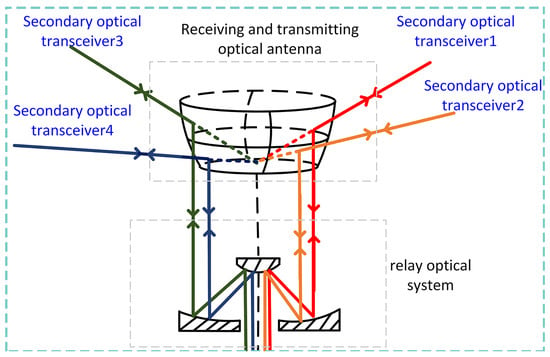
Figure 1
Open AccessArticle
Protecting the Quantum Coherence of Two Atoms Inside an Optical Cavity by Quantum Feedback Control Combined with Noise-Assisted Preparation
by
Chang-Xiao Li
Photonics 2024, 11(5), 400; https://doi.org/10.3390/photonics11050400 - 25 Apr 2024
Abstract
We propose a theoretical scheme to enhance quantum coherence and obtain steady-state coherence by combining quantum feedback control and noise-assisted preparation. We investigate the effects of quantum-jump-based feedback control and noise field on the quantum coherence and excited-state population between two atoms inside
[...] Read more.
We propose a theoretical scheme to enhance quantum coherence and obtain steady-state coherence by combining quantum feedback control and noise-assisted preparation. We investigate the effects of quantum-jump-based feedback control and noise field on the quantum coherence and excited-state population between two atoms inside an optical cavity where a noise field drives one, and the other is under quantum feedback control. It is found that steady quantum coherence can be achieved by adding an external noise field, and the quantum feedback can prolong the coherence time with partial suppression of the spontaneous emission of atoms. In addition, we study the influence of the joint action of quantum feedback and noise-assisted preparation on quantum coherence and show that the combined action of feedback control and noise-assisted preparation is more effective in enhancing steady coherence. The findings of our research offer some general guidelines for improving the steady-state coherence of coupled qubit systems and have the potential to be applied in the realm of quantum information technology.
Full article
(This article belongs to the Topic Recent Advances in Nonlinear Optics and Nonlinear Optical Materials)
►▼
Show Figures
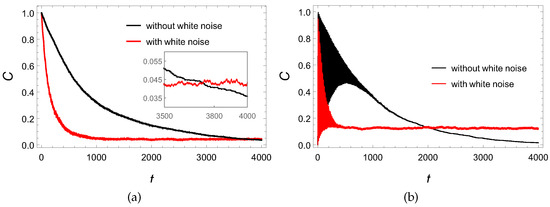
Figure 1
Open AccessArticle
High-Bandwidth Lumped Mach-Zehnder Modulators Based on Thin-Film Lithium Niobate
by
Peng Yang, Siwei Sun, Yuqiang Zhang, Rui Cao, Huimin He, Haiyun Xue and Fengman Liu
Photonics 2024, 11(5), 399; https://doi.org/10.3390/photonics11050399 - 25 Apr 2024
Abstract
Recently, lumped Mach-Zehnder Modulators (MZMs) have received renewed attention due to their potential for low power consumption and compact size. However, the practicality of lumped MZMs with conventional lumped electrodes (C−LEs) is limited by their lower electro−optical (EO) bandwidth. The reduction in EO
[...] Read more.
Recently, lumped Mach-Zehnder Modulators (MZMs) have received renewed attention due to their potential for low power consumption and compact size. However, the practicality of lumped MZMs with conventional lumped electrodes (C−LEs) is limited by their lower electro−optical (EO) bandwidth. The reduction in EO bandwidth results from the inherent trade−off between EO bandwidth and half−wave voltage length product (
(This article belongs to the Section Optoelectronics and Optical Materials)
►▼
Show Figures

Figure 1
Open AccessArticle
Performance Evaluation and Error Tracing of Rotary Rayleigh Doppler Wind LiDAR
by
Jianfeng Chen, Chenbo Xie, Jie Ji, Leyong Li, Bangxin Wang, Kunming Xing and Ming Zhao
Photonics 2024, 11(5), 398; https://doi.org/10.3390/photonics11050398 - 25 Apr 2024
Abstract
In the study of atmospheric wind fields from the upper troposphere to the stratosphere (10 km to 50 km), direct detection wind LiDAR is considered a promising method that offers high-precision atmospheric wind field data. In 2020, Xie et al. of the Anhui
[...] Read more.
In the study of atmospheric wind fields from the upper troposphere to the stratosphere (10 km to 50 km), direct detection wind LiDAR is considered a promising method that offers high-precision atmospheric wind field data. In 2020, Xie et al. of the Anhui Institute of Optics and Fine Mechanics, Chinese Academy of Sciences, developed an innovative rotating Rayleigh Doppler wind LiDAR (RRDWL). The system aims to achieve single-LiDAR detection of atmospheric wind fields by rotating the entire device cabin. In 2022, the feasibility of the system was successfully validated in laboratory conditions, and field deployment was completed. Due to the structural differences between this system and traditional direct-detection wind LiDAR, performance tests were conducted to evaluate its continuous detection capability in outdoor environments. Subsequently, based on the test results and error analysis, further analysis was carried out to identify the main factors affecting the system’s detection performance. Finally, the error analysis and traceability of the detection results were conducted, and corresponding measures were discussed to provide a theoretical foundation for optimizing the performance of RRDWL.
Full article
(This article belongs to the Special Issue Laser as a Detection: From Spectral Imaging to LiDAR for Remote Sensing Applications)
►▼
Show Figures
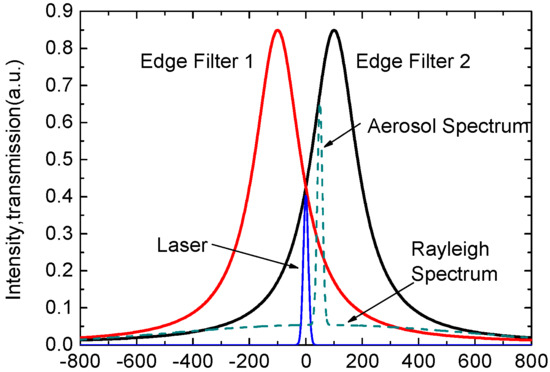
Figure 1
Open AccessArticle
Spatially Resolved, Real-Time Polarization Measurement Using Artificial Birefringent Metallic Elements
by
Stefan Belle, Stefan Kefer and Ralf Hellmann
Photonics 2024, 11(5), 397; https://doi.org/10.3390/photonics11050397 - 24 Apr 2024
Abstract
Polarization states define a fundamental property in optics. Consequently, polarization state characterization is essential in many areas of both field industrial applications and scientific research. However, a full identification of space-variant Stokes parameters faces great challenges, like multiple power measurements. In this contribution,
[...] Read more.
Polarization states define a fundamental property in optics. Consequently, polarization state characterization is essential in many areas of both field industrial applications and scientific research. However, a full identification of space-variant Stokes parameters faces great challenges, like multiple power measurements. In this contribution, we present a spatially resolved polarization measurement using artificial birefringent metallic elements, the so-called hollow waveguides. Differently oriented and space-variant hollow waveguide arrays, a stationary analyzer and a CMOS camera form the basis of the experimental setup for one single spatially resolved power measurement. From this power measurement, the Stokes parameters can be calculated in quasi-real-time, with a spatial resolution down to 50
(This article belongs to the Special Issue Polarization Optics)
Open AccessArticle
Depth Measurement Error Analysis and Structural Parameter Correction of Structured Light Depth Imager
by
Shuang Yu, Haoran Guo, Wenlong Yang, Yanqiao Zhao, Haibin Wu, Xiaoming Sun and Xiaoyang Yu
Photonics 2024, 11(5), 396; https://doi.org/10.3390/photonics11050396 - 24 Apr 2024
Abstract
Considering that structured light depth imagers are difficult to use for precision measurements due to their limited measurement accuracy, we propose an innovative method for correcting structural parameters of structured light depth imagers to reduce the depth measurement error caused by structural parameter
[...] Read more.
Considering that structured light depth imagers are difficult to use for precision measurements due to their limited measurement accuracy, we propose an innovative method for correcting structural parameters of structured light depth imagers to reduce the depth measurement error caused by structural parameter errors. For the structured light depth imager, the analytical imaging model is established, and the model of depth error caused by structural parameter errors is established based on the analysis of the depth measurement error analysis. Then, structural parameters are corrected according to the depth measurement error analysis and processing based on experimental depth imaging data of the standard reference plane at the maximum depth. As a result, the corrected analytical imaging model and corrected depth measurement values are obtained. Experimental results have demonstrated the success of this proposed method and its simplicity and convenience.
Full article
(This article belongs to the Special Issue Optical Devices/Components/Coatings for Ultra-Precision Equipment)
►▼
Show Figures
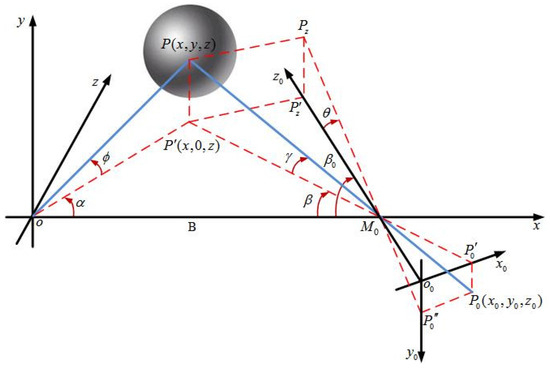
Figure 1
Open AccessArticle
Investigation of Characteristics of Ultraviolet Light Pulse Weak Signal Communication System Based on Fourth-Order Frequency-Shift Keying Modulation
by
Yingkai Zhao, Axin Du, Yu Jiao, Li Kuang, Jiawen Chen, Ning Sun and Jianguo Liu
Photonics 2024, 11(5), 395; https://doi.org/10.3390/photonics11050395 - 24 Apr 2024
Abstract
In ultraviolet (UV) communication, On–Off Keying (OOK) is the primary modulation technique. Compared to OOK, frequency modulation offers stronger resistance to path attenuation. Currently, research on frequency modulation demodulation schemes for UV communication is limited, mainly employing waveform detection and laser pulse response
[...] Read more.
In ultraviolet (UV) communication, On–Off Keying (OOK) is the primary modulation technique. Compared to OOK, frequency modulation offers stronger resistance to path attenuation. Currently, research on frequency modulation demodulation schemes for UV communication is limited, mainly employing waveform detection and laser pulse response methods, which require high detection sensitivity to light. This study presents a novel frequency modulation communication scheme using discrete Poisson channel distribution and optical pulse signal processing algorithms, enhancing the signal processing sensitivity of the existing frequency modulation scheme to the level of photons. The proposed system model is rigorously evaluated through theoretical derivations and simulations. Additionally, a hardware system integrating optical pulse counting, frequency detection, and clock data recovery algorithms is developed. Experimental results show the system achieving a 5 kbps transmission rate under frequency modulation. In non-line-of-sight (NLOS) scenarios, communication reaches up to 65 m, with the receiver elevation angle ranging from 10° to 25° and the bit error rate (BER) stabilized at 10−4, while in line-of-sight (LOS) situations, the BER remains at 10−5 up to 400 m and 10−4 up to 700 m, achieving the farthest distance and fastest communication rate achievable in the current FSK modulation scheme of ultraviolet communication systems. The integrated components enhance its applicability in communication systems. This study offers a valuable addition to UV communication technology.
Full article
(This article belongs to the Section Optical Communication and Network)
►▼
Show Figures

Figure 1
Open AccessArticle
Uniform Lighting of High-Power LEDs at a Short Distance to Plants for Energy-Saving and High-Density Indoor Farming
by
Ten It Wong and Xiaodong Zhou
Photonics 2024, 11(5), 394; https://doi.org/10.3390/photonics11050394 - 24 Apr 2024
Abstract
A tunable LED panel with multiple types of LEDs on a panel can provide various spectra for optimal plant growth. However, it is difficult for a lighting panel with multiple types of high-power LEDs to achieve uniform lighting. We demonstrated that by using
[...] Read more.
A tunable LED panel with multiple types of LEDs on a panel can provide various spectra for optimal plant growth. However, it is difficult for a lighting panel with multiple types of high-power LEDs to achieve uniform lighting. We demonstrated that by using optical reflectors at the sides of an LED panel to trap photons of LED arrays or using both the above-mentioned reflectors and optical lenses on each LED, high lighting uniformity can be achieved at a short distance to plants. The ray tracing simulation results show that the LED panel equipped with reflectors and optical lenses can achieve a high uniformity of >0.80 when the LED-plant distance is at half of the LED array’s pitch. We further verified that an LED panel (at a size of 88 cm × 54 cm) installed with reflectors can achieve light uniformities around 0.90 at a 15 cm LED-plant distance for the 6 types of LEDs (4 color LEDs and 2 white LEDs) on the panel. Compared with a branded tunable LED panel, our LED panel saves >25 cm vertical distance for each tier of plants and has 92.5% higher photon efficacy for 660 nm LEDs that exist on both panels.
Full article
(This article belongs to the Section Optoelectronics and Optical Materials)
►▼
Show Figures

Figure 1
Open AccessCommunication
Linear Fiber Laser Configurations for Optical Concentration Sensing in Liquid Solutions
by
Liliana Soares, Rosa Ana Pérez-Herrera, Susana Novais, António Ferreira, Susana Silva and Orlando Frazão
Photonics 2024, 11(5), 393; https://doi.org/10.3390/photonics11050393 - 24 Apr 2024
Abstract
In this study, different configurations based on linear fiber lasers were proposed and experimentally demonstrated to measure the concentration of liquid solutions. Samples of paracetamol liquid solutions with different concentrations, in the range from 52.61 to 201.33 g/kg, were used as a case-study.
[...] Read more.
In this study, different configurations based on linear fiber lasers were proposed and experimentally demonstrated to measure the concentration of liquid solutions. Samples of paracetamol liquid solutions with different concentrations, in the range from 52.61 to 201.33 g/kg, were used as a case-study. The optical gain was provided by a commercial bidirectional Erbium-Doped Fiber Amplifier (EDFA) and the linear cavity was obtained using two commercial Fiber Bragg Gratings (FBGs). The main difference of each configuration was the coupling ratio of the optical coupler used to extract the system signal. The sensing head corresponded to a Single-Mode Fiber (SMF) tip that worked as an intensity sensor. The results reveal that, despite the optical coupler used (50:50, 60:40, 70:30 or 80:20), all the configurations reached the laser condition, however, the concentration sensing was only possible using a laser drive current near to the threshold value. The configurations using a 70:30 and an 80:20 optical coupler allowed paracetamol concentration measurements with a higher sensitivity of (
(This article belongs to the Special Issue Single Frequency Fiber Lasers and Their Applications)
►▼
Show Figures
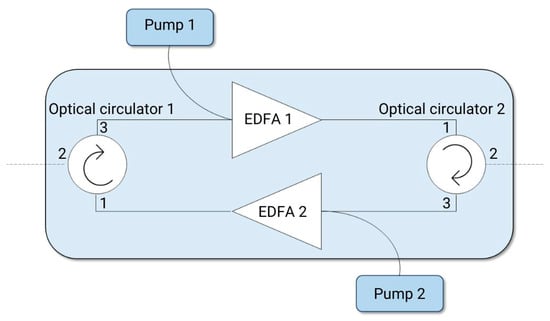
Figure 1
Open AccessArticle
High-Efficiency and Large-Angle Homo-Metagratings for the Near-Infrared Region
by
Wei-Cheng Tsai, Chia-Hsun Chang, Tai-Cherng Yu, Yi-Hsuan Huang, Chi-Wai Chow, Yu-Heng Hong, Hao-Chung Kuo and Yao-Wei Huang
Photonics 2024, 11(5), 392; https://doi.org/10.3390/photonics11050392 - 24 Apr 2024
Abstract
Compact photonic devices that integrate metasurfaces with light sources have been widely studied. However, experimental demonstrations of a higher efficiency of integration are still lacking. To enhance the efficiency of light sources integrated with metasurfaces, we employed a forward design optimization method and
[...] Read more.
Compact photonic devices that integrate metasurfaces with light sources have been widely studied. However, experimental demonstrations of a higher efficiency of integration are still lacking. To enhance the efficiency of light sources integrated with metasurfaces, we employed a forward design optimization method and index matching between the light source and metasurface substrate to design metagratings. To optimize the overall diffraction efficiency, we manipulated the degrees of freedom in phase, the lattice constants, and the number of unit cells. The same material was utilized for the nanostructures and substrate (homo-metagrating) for index matching, while Si and GaAs materials were used for working at 1550 and 940 nm, respectively. The experimental homo-metagratings operating at 1550 nm and made of Si exhibited an overall average efficiency of 51.3% at diffraction angles of 60.3°. On the other hand, experimental homo-metagratings operating at 940 nm and made of GaAs exhibited an overall average efficiency of 52.4% at diffraction angles of 49.3°. This suggests that the future integration of metagratings with a polarization-specific laser can further enhance the overall diffraction efficiency.
Full article
(This article belongs to the Special Issue Advanced Lasers and Their Applications)
►▼
Show Figures
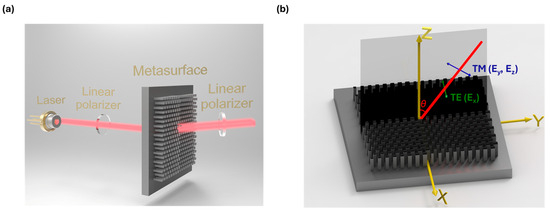
Figure 1
Open AccessArticle
Double-Cycle Alternating-Flow Diode Pumped Potassium Vapor Laser
by
Songyang Liu, Rongqing Tan, Wenning Xu, Fangjin Ning and Zhiyong Li
Photonics 2024, 11(5), 391; https://doi.org/10.3390/photonics11050391 - 23 Apr 2024
Abstract
A novel double-cycle alternating-flow diode-pumped potassium vapor laser is proposed, theoretically modeled and simulated. The results show that the optical-to-optical efficiency of the laser increases with increasing gas flow rates, although at high flow rates the rate of increase in efficiency decreases. The
[...] Read more.
A novel double-cycle alternating-flow diode-pumped potassium vapor laser is proposed, theoretically modeled and simulated. The results show that the optical-to-optical efficiency of the laser increases with increasing gas flow rates, although at high flow rates the rate of increase in efficiency decreases. The optical-to-optical efficiency reaches 74.8% at a pump power density of 30 kW/cm2 and a gas flow rate of 50 m/s. The optical-to-optical efficiency of the laser is greater with a narrow linewidth pump and high buffer gas pressure. The optical-to-optical efficiency of a flow gas cell is higher than that of a static gas cell. There is an optimal gas cell length that provides the highest optical-to-optical efficiency. At higher pump power densities, higher flow rates are required to obtain higher optical-to-optical efficiencies.
Full article
(This article belongs to the Special Issue High-Power Infrared Laser Systems: Design, Characterization, and Applications)
►▼
Show Figures
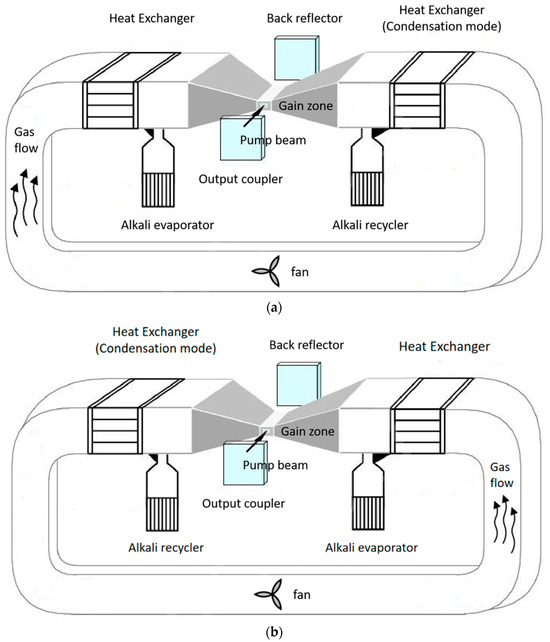
Figure 1
Open AccessArticle
Modulation Format Identification Based on Multi-Dimensional Amplitude Features for Elastic Optical Networks
by
Ming Hao, Wei He, Xuedong Jiang, Shuai Liang, Wei Jin, Lin Chen and Jianming Tang
Photonics 2024, 11(5), 390; https://doi.org/10.3390/photonics11050390 - 23 Apr 2024
Abstract
A modulation format identification (MFI) scheme based on multi-dimensional amplitude features is proposed for elastic optical networks. According to the multi-dimensional amplitude features, incoming polarization division multiplexed (PDM) signals can be identified as QPSK, 8QAM, 16QAM, 32QAM, 64QAM and 128QAM signals using the
[...] Read more.
A modulation format identification (MFI) scheme based on multi-dimensional amplitude features is proposed for elastic optical networks. According to the multi-dimensional amplitude features, incoming polarization division multiplexed (PDM) signals can be identified as QPSK, 8QAM, 16QAM, 32QAM, 64QAM and 128QAM signals using the k-nearest neighbors (KNNs) algorithm in the digital coherent receivers. The proposed scheme does not require any prior training or optical signal-to-noise ratio (OSNR) information. The performance of the proposed MFI scheme is verified based on numerical simulations with 28GBaud PDM-QPSK/-8QAM/-16QAM/-32QAM/-64QAM/-128QAM signals. The results show that the proposed scheme can achieve 100% of the correct MFI rate for all six modulation formats when the OSNR values are greater than their thresholds corresponding to the 20% forward error correction (FEC) related to a BER of 2.4 × 10−2. Meanwhile, the effects of residual chromatic dispersion, polarization mode dispersion and fiber nonlinearities on the proposed scheme are also explored. Finally, the computational complexity of the proposed scheme is analyzed, which is compared with relevant MFI schemes. The work indicates that the proposed technique could be regarded as a good candidate for identifying modulation formats up to 128QAM.
Full article
(This article belongs to the Special Issue Optical Performance Monitoring)
►▼
Show Figures
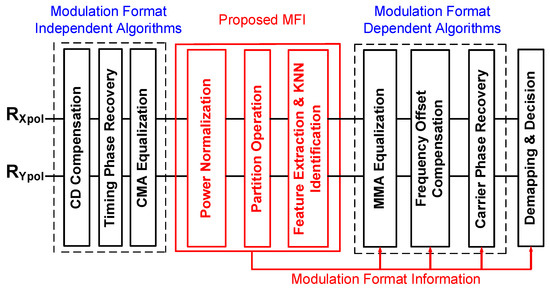
Figure 1

Journal Menu
► ▼ Journal Menu-
- Photonics Home
- Aims & Scope
- Editorial Board
- Reviewer Board
- Topical Advisory Panel
- Instructions for Authors
- Special Issues
- Topics
- Sections
- Article Processing Charge
- Indexing & Archiving
- Editor’s Choice Articles
- Most Cited & Viewed
- Journal Statistics
- Journal History
- Journal Awards
- Conferences
- Editorial Office
Journal Browser
► ▼ Journal BrowserHighly Accessed Articles
Latest Books
E-Mail Alert
News
Topics
Topic in
Materials, Nanomaterials, Photonics, Polymers, Applied Sciences, Sensors
Optical and Optoelectronic Properties of Materials and Their Applications
Topic Editors: Zhiping Luo, Gibin George, Navadeep ShrivastavaDeadline: 20 May 2024
Topic in
Applied Sciences, JMMP, Materials, Photonics, Plasma
Hybrid and Heterogeneous Integration on Photonic Circuits
Topic Editors: Joan Manel Ramírez, Carlos Alberto Alonso-RamosDeadline: 31 May 2024
Topic in
Applied Sciences, Electronics, Photonics, Remote Sensing, Technologies
Emerging Terahertz Technologies for Integrated Sensing and Communication
Topic Editors: Jianjun Ma, Xiue Bao, Bin Li, Suman MukherjeeDeadline: 31 July 2024
Topic in
Applied Sciences, Electronics, Optics, Photonics, Technologies
The Extended Technological Platform Based on Optics and Microwaves: Conventional and Hybrid Solutions
Topic Editors: Francesco Prudenzano, Antonella D’Orazio, Maurizio FerrariDeadline: 30 September 2024

Conferences
Special Issues
Special Issue in
Photonics
Optical Systems for Astronomy
Guest Editors: Eduard Muslimov, Gennady G. ValyavinDeadline: 30 April 2024
Special Issue in
Photonics
Advances in Infrared Spectroscopy and Raman Spectroscopy
Guest Editors: Zehua Han, Yujie ShenDeadline: 20 May 2024
Special Issue in
Photonics
Optical Technologies Supporting 5G/6G Mobile Networks
Guest Editors: Zbigniew Zakrzewski, Mariusz Głąbowski, Piotr Zwierzykowski, Vincenzo Eramo, Francesco Giacinto LavaccaDeadline: 31 May 2024
Special Issue in
Photonics
Micro-Nano Optical Devices
Guest Editors: Yan Shen, Yanfeng ZhangDeadline: 15 June 2024



